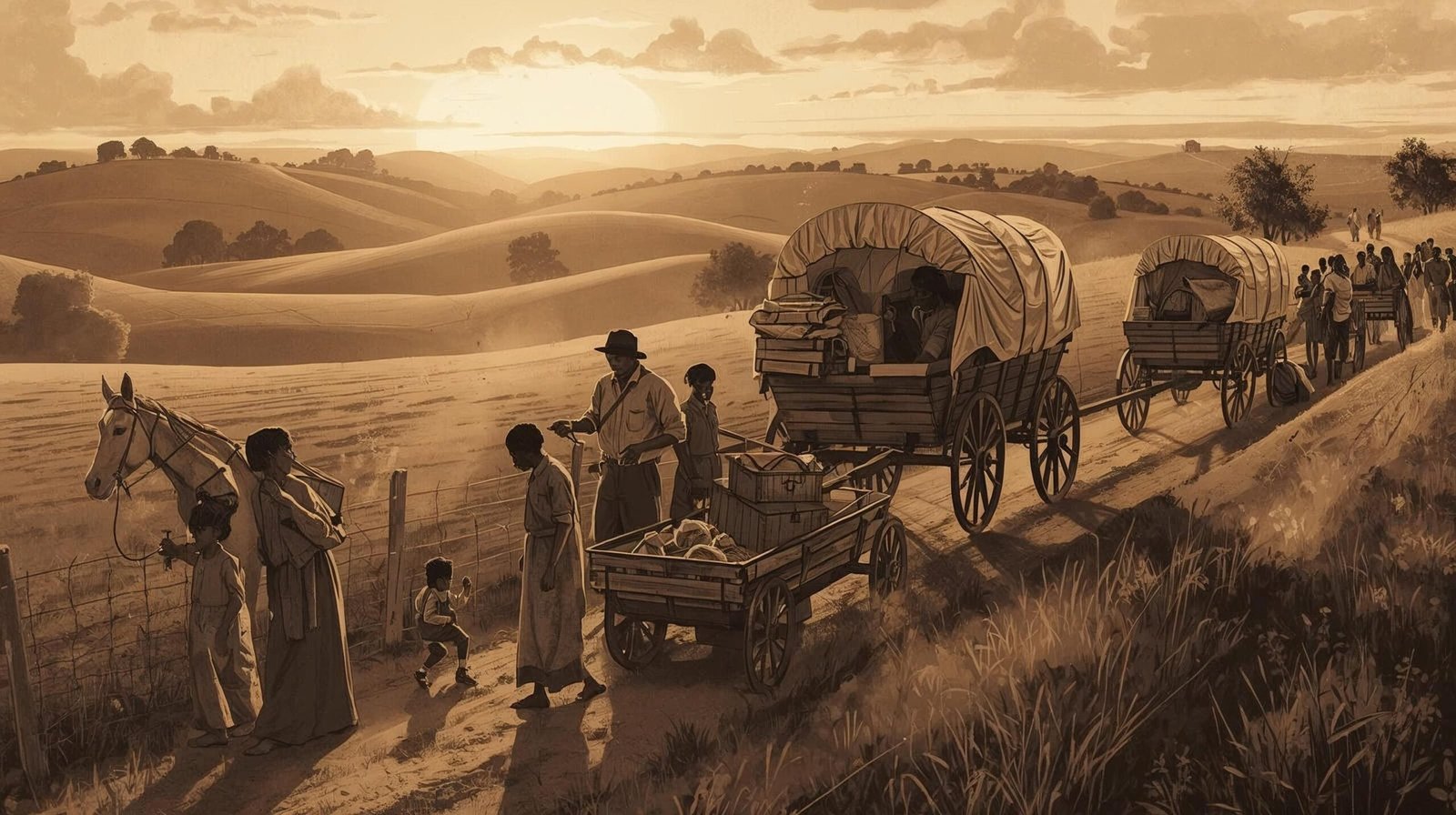The Warmth of Other Suns Summary: 11 Unforgettable Lessons from Isabel Wilkerson’s Epic Chronicle of Migration
The Warmth of Other Suns Summary stands as one of the most magnificent historical narratives of the twentieth century. Isabel Wilkerson, a Pulitzer Prize–winning journalist, masterfully captures the colossal movement of six million African Americans from the rural South to the cities of the North and West between 1915 and 1970. This migration reshaped the political, cultural, and economic landscape of the United States.
In The Warmth of Other Suns, Wilkerson constructs a deeply humane story through the intertwined lives of three individuals — Ida Mae Gladney, George Starling, and Robert Pershing Foster. Through their journeys, she unveils the endurance of the human spirit and the eternal longing for dignity, freedom, and self-determination.
This the warmth of other suns summary will delve into the heart of Wilkerson’s work, uncovering eleven powerful lessons that continue to echo in modern society. It is a story not merely about migration but about transformation — of individuals, communities, and a nation.

Lesson 1: The Great Migration — America’s Silent Exodus
At its core, The Warmth of Other Suns chronicles the Great Migration — a silent revolution that redefined American identity. For over half a century, millions of African Americans fled the Jim Crow South, seeking liberty and livelihood in cities like Chicago, New York, Los Angeles, and Detroit.
The warmth of other suns summary reveals that this migration was not just an act of escape but one of empowerment. Families left behind the cruelty of segregation, lynching, and disenfranchisement to pursue the “warmth” of possibility elsewhere. The courage of those who dared to leave laid the foundation for future generations to thrive in a freer America.
Lesson 2: The Power of Ordinary Lives
Wilkerson’s genius lies in her choice of protagonists — not politicians or celebrities but everyday heroes. Ida Mae Gladney represents the agricultural South; George Starling embodies the educated middle class; Robert Pershing Foster symbolizes ambition and upward mobility.
Through these lives, the warmth of other suns summary becomes an ode to ordinary people who, by sheer resilience, carved extraordinary paths. Their decisions to leave were private acts of rebellion that collectively reshaped the nation’s social fabric.
Lesson 3: The Psychological Weight of Oppression
The warmth of other suns summary makes one confront the psychological dimensions of racial subjugation. Wilkerson describes how the constant threat of violence, economic exploitation, and humiliation corroded self-worth. Leaving the South was not merely geographic — it was psychological liberation.
Her writing exposes the profound cost of living under systemic injustice. The migrants, once free, still bore the invisible scars of decades of degradation. Their journey was both physical escape and emotional rebirth.
Lesson 4: The Search for Identity in a Divided America
One of the most compelling insights in the warmth of other suns summary is the struggle of identity among those who left. Many migrants entered urban America with hope, only to confront new forms of discrimination in housing, employment, and education.
They were neither fully accepted by white America nor entirely understood by those who stayed behind. Yet out of this duality emerged a new African American consciousness — urban, articulate, and determined. This new identity birthed the cultural renaissance that transformed music, literature, and politics.
Lesson 5: The Role of Courage and Hope
Every page of the warmth of other suns summary radiates courage — not the grand gestures of history but the quiet bravery of families who chose to leave all they knew. Hope became their compass.
Despite poverty, rejection, and discrimination in their new homes, they persisted. Wilkerson’s portrayal reminds us that courage is not the absence of fear but the determination to move forward despite it. The migrants’ journeys teach modern readers that progress demands both risk and faith.

Lesson 6: The Birth of Cultural Renaissance
The warmth of other suns summary reveals that this migration did not merely alter demographics; it ignited a cultural explosion. Jazz, blues, literature, and political activism flourished as Black voices found freedom in northern cities.
From Langston Hughes to Louis Armstrong, from Richard Wright to Lorraine Hansberry — the diaspora enriched the nation’s soul. The art, rhythm, and intellect born from migration reshaped American culture, making it more inclusive and imaginative.
Lesson 7: The Inevitability of Resistance
Resistance is a recurring theme in The Warmth of Other Suns. The warmth of other suns summary illustrates how systemic barriers continued even outside the South. Redlining, employment bias, and social exclusion persisted. Yet, migrants fought back through unions, churches, community organizations, and civil rights activism.
Wilkerson’s work teaches that injustice evolves but so does resistance. Each generation inherits the responsibility to confront new forms of inequality — and to preserve the flame of freedom kindled by their forebears.
Lesson 8: The Strength of Family and Community
Migration was rarely an individual act; it was sustained by the strength of family. The warmth of other suns summary portrays women as the moral anchors of this transformation. They preserved dignity, nurtured children, and built networks that sustained entire communities.
Churches, fraternities, and neighborhood associations became sanctuaries of hope. The story demonstrates that progress thrives not in isolation but through collective resilience and mutual support.
Lesson 9: The Cost of Displacement
While The Warmth of Other Suns celebrates triumph, it also mourns what was lost. The warmth of other suns summary poignantly captures the pain of leaving behind ancestral land, memories, and kin.
For many migrants, freedom carried loneliness. Cities promised opportunity but demanded assimilation. The dialects faded, traditions waned, and communities scattered. Yet, Wilkerson reminds us that migration is a universal act of human aspiration — the willingness to trade certainty for possibility.
Lesson 10: History’s Mirror to the Present
Perhaps the most relevant aspect of the warmth of other suns summary lies in its reflection on contemporary America. The themes of migration, identity, and systemic inequality remain deeply pertinent.
Wilkerson’s narrative compels readers to confront ongoing racial and economic divides. The story of the Great Migration becomes a moral mirror — urging society to examine its conscience and its unfinished journey toward justice.

Lesson 11: The Enduring Light of Human Spirit
In the closing chapters, the warmth of other suns summary culminates in a celebration of the indomitable human spirit. Wilkerson’s writing soars with compassion and poetic depth. Despite adversity, the migrants discovered the warmth of dignity — the sunlight of freedom they had sought all their lives.
Their legacy endures in every artist, activist, and dreamer who refuses to be confined by circumstance. The Warmth of Other Suns is, ultimately, a hymn to human endurance and moral awakening.
Writing Style and Historical Precision
Isabel Wilkerson’s narrative technique deserves admiration. The warmth of other suns summary demonstrates her meticulous research — hundreds of interviews, decades of documentation, and a journalist’s eye for detail. Her prose flows like a symphony of memory and fact.
She weaves data with empathy, making history breathe. Her storytelling transforms statistics into souls, ensuring that readers not only learn but feel the migration’s magnitude. The warmth in her words mirrors the warmth her characters longed for — that of acceptance, belonging, and hope.
Impact on American Consciousness
Few works in modern literature have altered historical understanding as profoundly as The Warmth of Other Suns. The warmth of other suns summary testifies to its transformative power. It compels readers to recognize that America’s progress owes an unpayable debt to those who moved northward and westward against all odds.
Their exodus built modern America — its cities, industries, and cultural ethos. The book remains essential reading for anyone seeking to comprehend the roots of today’s racial landscape.
Critical Reception and Legacy
Since its publication, The Warmth of Other Suns has received universal acclaim. The warmth of other suns summary reflects the book’s intellectual and emotional breadth — winning the National Book Critics Circle Award and being named among the best books of the century.
Critics hailed it as a “monument of empathy” and a “masterpiece of narrative history.” More than a decade later, it continues to shape discussions on race, migration, and the American dream.
Why Every Reader Should Read It
The warmth of other suns summary urges every reader to engage with this monumental work. It is not just history — it is a mirror of human resilience. For students, it offers insight; for citizens, it offers conscience; for dreamers, it offers courage.
Wilkerson teaches us that freedom, once earned, must be preserved; that dignity, once lost, must be reclaimed; and that empathy, once felt, must be extended to all.

The Human Cost and Moral Awakening of a Nation
While readers often celebrate the Great Migration as a triumph of courage and progress, Isabel Wilkerson reminds us that such movements are never free from moral cost. The warmth of other suns summary compels one to recognize that this exodus was both a testimony to freedom and an indictment of a society that made escape necessary. It was the failure of the American South to uphold the principles of democracy that forced millions of its citizens to depart.
Families torn apart, ancestral homes abandoned, and friendships dissolved — these were the invisible tolls of migration. The spiritual trauma of leaving one’s birthplace haunted generations. Yet, in the act of leaving, the migrants redefined patriotism itself: they loved their country enough to demand that it love them back. Wilkerson’s writing captures this paradox with rare dignity, reminding us that real loyalty is rooted not in blind acceptance but in the desire for justice.
The book’s enduring power lies in its moral resonance. It asks readers to confront not only the past but also the conscience of the present. To read The Warmth of Other Suns is to awaken to the reality that freedom, once denied, must be cherished — and that silence in the face of injustice is a quiet form of complicity.
Urban Challenges and New Beginnings
When migrants reached northern and western cities, they were greeted not by open arms but by walls of prejudice and exclusion. The warmth of other suns summary vividly portrays these contradictions. The migrants who fled racial terror in the South often found themselves restricted by housing covenants, segregated schools, and discriminatory employment practices in the North.
Nevertheless, they persevered. They built new churches, formed social clubs, and established local businesses that became pillars of emerging Black urban life. Their neighborhoods, though initially neglected by the state, evolved into vibrant cultural enclaves — places of music, art, and shared identity.
In this environment, children of migrants learned to balance two worlds: the ancestral South preserved in family memory and the dynamic, modern city they called home. This fusion produced new traditions, new art forms, and a fresh moral vision of citizenship. It also birthed a generation of activists who would one day lead the Civil Rights Movement.
Through this lens, the warmth of other suns summary reveals migration not merely as an escape but as an act of creation. The migrants were not refugees from oppression alone; they were architects of a new national identity. Their footprints across the continent marked the geography of freedom itself.
Wilkerson’s Vision and the Art of Empathy
One of the greatest strengths of Wilkerson’s narrative is her ability to blend scholarship with compassion. She transforms her exhaustive research into living emotion. The warmth of other suns summary shows that empathy, not statistics, is the key to understanding history.
Her prose is precise yet lyrical, like a melody sustained by truth. She allows readers to inhabit the minds of her protagonists — to feel the anxiety of departure, the tension of arrival, and the bittersweet taste of freedom. The author’s voice never moralizes; it humanizes. Each story becomes an invitation to witness courage in its most unadorned form.
In doing so, Wilkerson achieves what few historians have managed — she reclaims the lost humanity behind numbers and maps. Every page reminds readers that history is not a procession of dates but a constellation of personal struggles and moral victories. Her narrative approach transforms the book into an ethical compass, guiding readers toward compassion and self-reflection.
The Relevance of Migration in the Modern Era
The warmth of other suns summary resonates profoundly in an age defined by global migration and displacement. Although the Great Migration was uniquely American, its emotional contours are universal. Across continents, millions still leave their homelands seeking safety, dignity, and opportunity — echoing the same longing for “the warmth of other suns.”
Wilkerson’s message transcends geography and race: it speaks to anyone who has ever felt compelled to move toward freedom. Her work invites policymakers, educators, and citizens alike to view migration not as a threat but as a testament to human resilience.
In a world increasingly divided by walls — literal and ideological — her book offers a moral reminder that societies flourish when they open themselves to the hopes of the displaced. The lesson is timeless: progress begins when empathy replaces fear.
From Memory to Legacy
Today, descendants of the Great Migration occupy positions of influence across every sphere of American life — politics, academia, music, art, and science. Their success testifies to the enduring impact of those who sought the warmth of liberty. The cultural footprints of migration extend from Harlem’s jazz clubs to California’s universities, from the marches of Selma to the corridors of power in Washington.
Each triumph of that generation’s descendants is a quiet salute to the courage of those who packed their bags and boarded northbound trains in search of dignity. The warmth of other suns summary thus becomes more than history; it becomes inheritance — a living document of struggle transformed into strength.
Wilkerson’s chronicle ensures that their sacrifices are not forgotten, their voices not silenced, and their dreams not diminished by time. Her book stands as a bridge between memory and modernity — between the past’s pain and the present’s promise.

The Ethical Lesson for Modern Readers
To engage with The Warmth of Other Suns is to confront one’s own moral responsibility. It challenges each reader to examine where injustice persists today — in housing, education, employment, or public discourse — and to act with integrity.
Wilkerson’s narrative calls for empathy not only across races but across generations. It demands that we see in others the same yearning for warmth that defined those historic journeys. In doing so, the book elevates history to a moral philosophy.
The true legacy of this migration is not merely demographic change; it is a vision of shared humanity. As modern readers absorb its lessons, they are reminded that justice, once earned, must be continually defended; that liberty, once granted, must be equally shared; and that progress, once achieved, must never be taken for granted.
FAQs About The Warmth of Other Suns Summary
Q1. Who is the author of The Warmth of Other Suns?
Isabel Wilkerson, a Pulitzer Prize–winning journalist, is the author. Her research and empathy make the narrative both scholarly and profoundly human.
Q2. What is the central theme of The Warmth of Other Suns Summary?
The central theme is the Great Migration of African Americans from the South to the North and West, seeking freedom and equality.
Q3. What lessons does The Warmth of Other Suns Summary teach?
It teaches lessons about courage, identity, resilience, and the power of hope in overcoming systemic injustice.
Q4. Is The Warmth of Other Suns based on true stories?
Yes. It is based on the real-life experiences of Ida Mae Gladney, George Starling, and Robert Pershing Foster, representing millions who migrated.
Q5. Why is The Warmth of Other Suns Summary relevant today?
Because it echoes current social struggles, urging empathy, justice, and understanding in an age still divided by inequality.
Conclusion
The warmth of other suns summary is not merely a retelling of historical migration — it is a revelation of human destiny. Through Isabel Wilkerson’s eloquence, the reader witnesses how endurance triumphs over oppression and how ordinary lives can change a nation’s fate.
As the migrants chased the warmth of other suns, they illuminated America’s conscience. Their courage remains an eternal lesson in faith, hope, and transformation.
At shubhanshuinsights.com, this reflection stands as a tribute to the silent heroes who shaped modern America. Their story is not only a historical account but a timeless reminder — that the warmth of other suns still glows within the hearts of all who seek freedom.